| 10 February |
• yesterday • tomorrow |
| Memorial of Saint Scholastica |
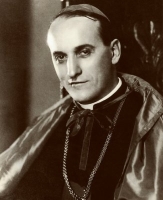
Aloysius Stepinac
Raised in the large Catholic Croatian family of Josip and Barbara (nee Penic) Stepinac. Graduated high school on 28 June 1916. Soldier in the Austrian army in World War I, fighting at several points in Italy. Following the collapse of the front in September 1918, he was imprisoned, then released and demobilized in December 1918.
Studied briefly at the Faculty of Agriculture in Zagreb, Croatia, but returned to work at home. He considered marriage, but realized a call to the priesthood, and began his studies in 1924. Studied at the Pontifical Germanicum-Hungaricum College, and earned doctorates in theology and philosophy at the Pontifical Gregorian University, Rome, Italy. Ordained 26 October 1930. Parish priest in the archdiocese of Zagreb. He worked especially in the poor neighbourhoods, and established the archdiocesan Caritas on 23 November 1931.
Named Co-adjutor Archbishop of Zagreb on 29 May 1934 by Pope Pius XI. Created twelve new parishes in the archdiocese, established close ties with lay associations and youth groups, promoted the Catholic press, and helped protect the rights of the Church from the Yugoslavian state. Succeeded Archbishop Bauer on 7 December 1937.
In 1936, the rise of Nazism prompted Stepinac to support a committee helping people fleeing the Reich. Instituted the Action for Assistance to Jewish Refugees in 1938. This period galvanized him a stout defender of human rights regardless of race, religion, nationality, ethnic group or social class, a fight he would continue the rest of his days. During the war, Stepinac helped hide countless people, mainly Jews, in monasteries and other Church property; some remained there throughout the war.
By 1945, Yugoslavia had replaced the oppression of the Nazis with the oppression of the Communists. Stepinac, wrote a biographer, "treated the new authorities…in accordance with the Gospel" but fought for the rights of the Church and the interests of Croatians. After publishing a letter denouncing the execution of priests by communist militants, Stepinac was arrested for the first time.
Following the Archbishop's release, Yugoslavia's new leader, Josip Broz Tito, tried to persuade him to have the Catholic Church in Croatia break from Rome. The Bishops of Yugoslavia issued a pastoral letter on 22 September 1945 in which they referred to the promises made - and broken - by the Belgrade government to respect freedom of conscience, freedom of religion, and private ownership of property. The Bishops demanded freedom for the Catholic press, Catholic schools, religious instruction, Catholic associations, and "full freedom for the human person and his inviolable rights, full respect for Christian marriage and the restitution of all confiscated properties and institutions". The state-run media launched an attack on the Church in general, and the archbishop by name.
Stepinac was tried in September 1946 for defending the unity of the Catholic Church in Croatia, and its unity with Rome. The Pope objected to this show trial, and members of the Jewish community in the United States protested, "…this great man has been accused of being a collaborator of the Nazis. We Jews deny this…. Alojzije Stepinac was one of the few men in Europe who raised his voice against the Nazi tyranny, precisely at the time when it was most dangerous to do so." On 11 October 1946, he was sentenced to 16 years of hard labour and the loss of his civil rights, such as they were.
On 5 December 1951, ill health forced the authorities to move Stepinac from prison to house arrest in Krasic. There he performed priestly functions, received visitors, and wrote more than 5,000 letters, none of which show the slightest resentment for those who persecuted him.
Created cardinal on 12 January 1953 by Pope Pius XII who called him "an example of apostolic zeal and Christian strength. [This is] to reward his extraordinary merits…and especially to honour and comfort our sons and daughters who resolutely confess their Catholic faith despite these difficult times." This apparently was too much for the Yugoslav regime who promptly broke diplomatic relations with Rome. Stepinac, however, retained his position and maintained his stance against the bullying government until his death, which may have been a murder to eliminate an annoyance to that government.
8 May 1898 at Brezaric, Krasic, Croatia as Alojzije Viktor Stepinac
• 10 February 1960 at Krasic, Croatia
• suffered from polycythemia rubra vera, thrombosis of the leg and bronchial catarrh, but may have been poisoned as arsenic was found in his bones during the beatification examination
3 October 1998 by Pope John Paul II at Marija Bistrica, Croatia
Lord, Our God, You bestowed on your servant Cardinal Alojzije Stepinac the grace to believe in Jesus Christ and also to suffer for Him with brave apostolic fervor and love towards the Church. Grant us the same faith and perseverance in suffering for the Church. Raise your servant to the glory and honor of the saints so that he may be an example and intercede for us in life's battle towards our goal of eternal salvation. Through Christ, Our Lord. Amen.
Blessed be your name, Lord! May Your will be done! - Blessed Alojzije Stepinac's last words
We always stressed in public life the principles of God's eternal law regardless of whether we spoke about Croats, Serbs, Jews, Gypsies, Catholics, Muslims, Orthodox or whoever else…. The Catholic Church does not recognize races that rule and races that are enslaved. - Blessed Alojzije Stepinac, 1943
I know what my duty is. With the grace of God, I will carry it out to the end without hatred towards anyone, and without fear from anyone. - Blessed Alojzije Stepinac
https://catholicsaints.info/blessed-alojzije-stepinac/
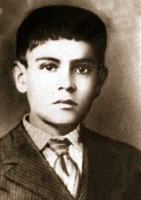
Childhood friend of Father Marcial Maciel who founded the Legionnaires of Christ and who witnessed José's death. At age 13 the boy became a flag-bearer in the Cristero army who were fighting to remain Catholic in the face of anti-religious government decrees; his two older brothers, Macario and Miguel, were soldiers, but no one would let José become a front-line soldier as he wanted. Captured by government troops, he was imprisoned, abused, mutilated, and ordered to renouce Christianity; José refused. Martyr.
28 March 1913 in Sahuayo, Michoacán de Ocampo, Mexico
• hacked with machetes, stabbed with bayonets and finally shot on 10 February 1928 in Sahuayo, Michoacán de Ocampo, Mexico
• interred in the Church of the Sacred Heart of Jesus, Sahuayo
• a bone fragment relic enshrined in the church of the Immaculate Conception, Taft, Texas
on 21 January 2016, Pope Francis promulgated a decree of a miracle received through the intercession of Blessed José
José Sánchez del Río was born on 28 March 1913 in Sahuayo, Michoacán, Mexico. Wanting to defend the faith and rights of Catholics, he followed in the footsteps of his two older brothers and asked his mother for permission to join the Cristeros. She objected, telling him that he was too young. "Mama", he replied, "do not let me lose the opportunity to gain Heaven so easily and so soon".
On 5 February 1928 the young boy was captured during a battle and imprisoned in the church sacristy. In order to terrorize him, soldiers made him watch the hanging of one of the other captured Cristeros. But José encouraged the man, saying, "You will be in Heaven before me. Prepare a place for me. Tell Christ the King I shall be with him soon".
In prison, he prayed the Rosary and sang songs of faith. He wrote a beautiful letter to his mother telling her that he was resigned to do God's will. José's father attempted to ransom his son, but was unable to raise the money in time.
On 10 February 1928 the teenager was brutally tortured and the skin of the soles of his feet was sheered off; he was then forced to walk on salt, followed by walking through the town to the cemetery. The young boy screamed with pain but would not give in.
At times the soldiers stopped him and said, "If you shout, "Death to Christ the King', we will spare your life". But he answered: "Long live Christ the King! Long live Our Lady of Guadalupe!".
Once he arrived at the cemetery, José was asked once more if he would deny his faith. The 14 year old shouted out: "Long live Christ the King!", and was summarily shot. - Vatican beatification biography
https://catholicsaints.info/blessed-jose-sanchez-del-rio/

Twin sister of Saint Benedict of Nursia. Born to the Italian noblility. Her mother died in childbirth. Nun. She led a community of women at Plombariola near Montecassino. See the Readings section below for Pope Saint Gregory the Great's telling of some of the stories of her life.
480 in Italy
• 543 of natural causes
• from his cell, Saint Benedict had a vision in which he saw her soul flying to heaven in the form of a dove
• against lightning
• against rain
• against storms
• Benedictines
• convulsive children
• nuns
• Le Mans, France
• Monte Cassino Abbey
• nun with crozier and crucifix
• nun with dove flying from her mouth
• dove
• lily
Scholastica, the sister of Saint Benedict, had been consecrated to God from her earliest years. She was accustomed to visiting her brother once a year. He would come down to meet her at a place on the monastery property, not far outside the gate. One day she came as usual and her saintly brother went with some of his disciples; they spent the whole day praising God and talking of sacred things. As night fell they had supper together. Their spiritual conversation went on and the hour grew late. The holy nun said to her brother, "Please do not leave me tonight; let us go on until morning talking about the delights of the spiritual life." "Sister," he replied, "What are you saying? I simply cannot stay outside my cell." When she heard her brother refuse her request, the holy woman joined her hands on the table, laid her head on them and began to pray. As she raised her head from the table, there were such brilliant flashes of lightning, such great peals of thunder and such a heavy downpour of rain that neither Benedict nor his brethren could stir across the threshold of the place where they had been seated. Sadly, he began to complain. "May God forgive you, sister. What have you done?" "Well, she answered, "I asked you and you would not listen; so I asked my God and he did listen. So now go off, if you can, leave me and return to your monastery." So it came about that they stayed awake the whole night, engrossed in their conversation about the spiritual life. Three days later, Benedict was in his cell. Looking up to the sky, he saw his sister's soul leave her body in the form of a dove, and fly up to the secret places of heaven. Rejoicing in her great glory, he thanked almighty God with hymns and words of praise. He then sent his brethren to bring her body to the monastery and lay it in the tomb he had prepared for himself. - from Dialogues by Pope Saint Gregory the Great
https://catholicsaints.info/saint-scholastica/
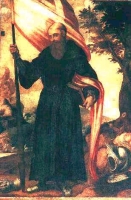
• William of Guyenne
• William of Malval
• William of Malvalla
• William of Poitiers
• William the Great
• William the Hermit
• Gulielmus, Wilhelmus
William lived a wild and dissolute life as a soldier in his youth. However, at some point he began to take his religion seriously, left the military life, and made pilgrimages to the Holy Lands. He became superior of an abbey at Pisa, Italy in 1153. He failed in this position, however, and became a hermit on Mount Bruno. He attracted followers, founded a monastery in 1154, and failed again as abbot. William returned to a life as a hermit, this time around Siena, Italy in 1155 in a wilderness called "Maleval" ("evil valley"). There he attracted followers who were called Williamites, Guillemites, or the barefoot friars. They first following William's severe rule, then the Benedictine, and later the Augustinian. They spread through Italy, France, and Germany, but have not survived until today.
French
10 February 1157 of natural causes
1202 (cultus confirmed) by Pope Innocent III
• Arms manufacturers
• armourers
• blacksmiths
• tinsmiths
• Castiglione della Pescaia, Italy
• Laoag, Philippines, diocese of
• San Fernando La Union, Philippines, diocese of
• man bearing a cross staff, one arm of which ends in a crescent
• man bearing a shield with four fleur-de-lys
• man wearing a monastic habit over armour
• man with a pilgrim's staff
https://catholicsaints.info/blessed-william-of-maleval/

• Chiara Agolanti
• Clara, Klara
Born to the nobility. Married twice, she spent most of her time in dissolute, sinful pleasures. When her father and brother were executed in civil disturbances, Clare changed her life completely. She became a Franciscan tertiary and founded a convent, though she never became a nun. In an attempt to make up for her earlier life, she practiced penances that were considered extreme even by 14th century standards, and once sold herself into slavery so she could use the money to buy a man out of prison; the local judge commuted the man’s sentence, had the money returned, and Clare was freed.
Legend says that once when some nuns of Rimini were freezing without fuel for their fires, Clare went into the woods, picked up a huge log, and started carrying it to the convent. A relative stopped her and said that it was beneath her dignity as a noble woman to carry wood like a servant. Clare said that if Jesus could carry great pieces of wood to Golgotha for the sake of sinners like her, she could hardly balk at carrying it for the brides of Christ.
1282 at Rimini, Italy
• 10 February 1344 at Rimini, Italy of natural causes
• interred at the convent she founded
22 December 1784 by Pope Pius VI (cultus confirmed)
https://catholicsaints.info/blessed-clare-agolanti-of-rimini/
• Alexander Baldrati
• Alexander Baldrati a Lugo
Alexander joined the Dominicans in Lugo, Italy in 1612, then studied in Faenza, Naples, and the convent of Our Lady of the Arch. Priest, assigned to Bologna, Italy soon after ordination. He worked himself so hard, in pulpit and with the needy, that he ruined his health and had to be reassigned to Venice, Italy to recover.
As part of his recovery, and to get him away from the over-work that had crushed him, he was sent by sea to the east. The ship stopped on the Greek island of Chios, and Alexander took the opportunity to preach to the locals. An apostate Christian there took the opportunity to stir up sentiment against Alexander, going to the Muslim authorities and swearing that Alexander had converted to Islam. Alexander was dragged to court, interrogated, and offered in rewards if he would bring other Dominicans to Islam. When he denied that he had ever converted to Islam, the court convicted him of being an apostate Muslim, and charged the Christian authorities of harbouring an apostate.
The archbishop and the Dominicans swore that Alexander had always been a Christian. When questioned again, Alexander denounced Islam, Mohammed, and the Koran. After an brief imprisonment, he was martyred by the Muslim authorities and local citizens.
1595 in Lugo, Italy
hacked to pieces and burned at the stake in 1645 on Chios Island, Greece
https://catholicsaints.info/blessed-alexander-of-lugo/

Austreberta, Eustreberta, Eustreverte
Daughter of Saint Framechildis and the Count Badefrid. Her parents arranged a marriage for her for political reasons, but Austrebertha was drawn to religious life. Benedictine nun, receiving the veil from Saint Omer at Abbeville, France. Abbess at Jumieges, and at Pavilly. Miracle worker and visionary; at one point in her early life she got a foreshadow of her life - she looked at her reflection in a river and saw a veil over her head.
630 at Therouanne, Artois, France
• 704 at Pavilly, Normandy, France
• relics transferred to Montreuil-sur-Mer, France to keep them safe during the Norman invasion
• relics burned in the French Revolution
Barentin, France
with a wolf (it had killed her donkey so she made it take over the donkey's duties)
https://catholicsaints.info/saint-austrebertha-of-pavilly/
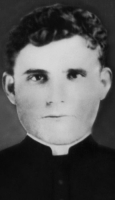
Received theological training from Bishop Ernest Çoba of Shkodrë, Albania. Ordained on 8 December 1961 as a priest of the archdiocese of Shkodrë-Pult, Albania. When the Communist government closed all churches in Albania in March 1967, Father Mikel travelled from village to village, ministering to the people, conducting covert Masses where he could. Arrested on 19 April 1973 in Beltoje, Albania, he was imprisoned for several months, tortured and finally given a trial; he used it to speak out against the Communists and their anti–Christian persecutions. Martyr.
9 May 1935 in Beltoj, Shkodrë, Albania
shot by firing squad on 10 February 1974 in Shkodrë, Albania
• 5 November 2016 by Pope Francis
• beatification celebrated at the Square of the Cathedral of Shën Shtjefnit, Shkodër, Albania, presided by Cardinal Angelo Amato
https://catholicsaints.info/blessed-mikel-beltoja/

Born to a poor but pious family, when she old enough she had to beg to help them survive. She felt a call to religious life, but worked as a servant in a wealthy household, then a nanny in an orphanage. Religious sister in the Institute of the Daughters of Mary, Help of Christians (Salesian Sisters). She worked as a cook and maid, but her spiritual insights were obvious, and many priests, religious and laity came to her for advice. She had the gift of prophecy, and helped spread devotion to the Wounds of Christ.
15 December 1899 in Cantalpino, Salamanca, Spain
10 February 1935 at Valverde del Camino, Huelva, Spain of natural causes
25 April 2004 by Pope John Paul II
https://catholicsaints.info/blessed-eusebia-palomino-yenes/
Soteris of Rome
Wealthy 3rd century noble family. A beatiful young woman, she consecrated herself to God. Unlike other women of her day, she dressed plainly with no ornamentation so men would ignore her, and lived a quiet, simple life, forshadowing the female religious orders in years to come. Arrested and tortured in her youth during the persecutions of Decius. Released, she returned to her prayerful life only to be murdered a half-century later in the persecutions of Diocletian for refusing sacrifice to pagan gods. All records indicate that, no matter the torture, she never once cried out. Saint Ambrose of Milan claimed she was one of his ancestor, and he wrote about her.
• beaten and beheaded on 10 February 304 in Rome, Italy
• buried in the Catacombs of San Callisto in Rome
https://catholicsaints.info/saint-soteris-the-martyr/

Caralampo, Charalambos, Charalampes, Charalampios, Charalampius, Charalampos, Charalampus, Chartalampus, Haralabos, Haralambos, Haralampos, Haralampus, Kharalampos
Elderly priest in Magnesia, Asia Minor (in modern Turkey). Tortured and martyred with Saint Baptus, Saint Porphyrius of Magnesia, and three unnamed Christian women during the persecutions of Emperor Septimius Severus.
• 203 in Magnesia, Asia Minor (in modern Turkey)
• skull enshrined in the monastery of Saint Stephen in Meteora in central Greece
• against plague
• against cattle diseases
• against cholera
https://catholicsaints.info/saint-charalampias/

2 January as one of the Martyrs of Anjou
Lay woman of the diocese of Angers, France. Martyred in the persecutions of the French Revolution.
29 June 1758 in Saint-Pierre de Chemillé, Maine-et-Loire, France
10 February 1794 in Avrillé, Maine-et-Loire, France
19 February 1984 by Pope John Paul II at Rome, Italy
https://catholicsaints.info/blessed-catherine-du-verdier-de-la-soriniere/

2 January as one of the Martyrs of Anjou
Lay woman of the diocese of Angers, France. Martyred in the persecutions of the French Revolution.
3 April 1765 in Jallais, Maine-et-Loire, France
10 February 1794 in Avrillé, Maine-et-Loire, France
19 February 1984 by Pope John Paul II at Rome, Italy
https://catholicsaints.info/blessed-marie-anne-hacher-du-bois/
2 January as one of the Martyrs of Anjou
Lay woman of the diocese of Angers, France. Martyred in the persecutions of the French Revolution.
27 June 1765 in Saint-Pierre de Chemillé, Maine-et-Loire, France
10 February 1794 in Avrillé, Maine-et-Loire, France
19 February 1984 by Pope John Paul II at Rome, Italy
https://catholicsaints.info/blessed-marie-louise-du-verdier-de-la-soriniere/
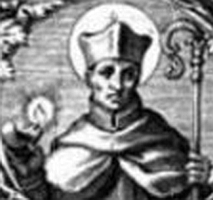
Hugues
Priest. Disciple of Saint Norbert, and succeeded him as superior general of the Premonstratensians. Under his leadership the Order grew to 120 houses.
at Fosse, Belgium
• 1164 of natural causes
• relics transferred to the Cathédrale Notre-Dame of Laon, France in 1896
13 July 1927 by Pope Pius XI (cultus confirmed)
https://catholicsaints.info/blessed-hugh-of-fosse/
2 January as one of the Martyrs of Anjou
Married lay woman of the diocese of Angers, France. Martyred in the persecutions of the French Revolution.
22 February 1754 in Le Longeron, Maine-et-Loire, France
10 February 1794 in Avrillé, Maine-et-Loire, France
19 February 1984 by Pope John Paul II at Rome, Italy
https://catholicsaints.info/blessed-louise-poirier-epouse-barre/
• Trumwin of Abercorn
• Trumwine, Trumma, Tumma, Trumwinus, Triumwini, Trumuini
Bishop of the Southern Picts in Scotland in 681; he worked from the monastery of Abercorn on the Firth of Forth. When King Egfrid was killed by the Picts in 685, Trumwin and his monks had to flee the area. Retired to spend his later years as a prayerful monk in Whitby, England.
c.704 of natural causes
https://catholicsaints.info/saint-trumwin-of-whitby/
Studied law at the University of Bologna, Italy. A friend of Saint Dominic de Guzman, Paul joined the Dominicans and returned to Hungary to establish the Order there. With a group of approximately 90 others, he travelled to Wallachia, an area of modern Romania, as a missionary to the pagan Cumans. They were all martyred.
Hungary
c.1240 in Wallachia (in modern Romania)
https://catholicsaints.info/blessed-paul-of-wallachia/
2 January as one of the Martyrs of Anjou
Layman of the diocese of Angers, France. Martyred in the persecutions of the French Revolution.
16 September 1754 in Chaudefonds, Maine-et-Loire, France
10 February 1794 in Avrillé, Maine-et-Loire, France
19 February 1984 by Pope John Paul II at Rome, Italy
https://catholicsaints.info/blessed-pierre-fremond/

Bapto, Baptos, Dauktos, Dauto
Eyewitness to executions of Christians who was so moved by their courage that he examined the faith and converted. Martyred with five companions during the persecutions of Emperor Septimius Severus.
203 in Magnesia, Asia Minor
https://catholicsaints.info/saint-baptus-of-magnesia/
Lay woman of the diocese of Angers, France. Martyred in the persecutions of the French Revolution.
22 August 1721 in Saint-Mars-des-Prés, Vendée France
10 February 1794 in Avrillé, Maine-et-Loire, France
19 February 1984 by Pope John Paul II at Rome, Italy
https://catholicsaints.info/blessed-louise-bessay-de-la-voute/
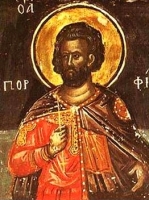
Porfyrius, Porphyrius, Porphyry
Imperial executioner who was so moved by the courage of the Christians he was murdering that he examined the faith and converted. Martyred with five companions during the persecutions of Emperor Septimius Severus.
203 in Magnesia, Asia Minor
https://catholicsaints.info/saint-porfirio/
Born to the Spanish nobility, he became ambassador from the Spanish throne to the Republic of Venice (in modern Italy). Leaving the worldly life, he became a Camaldolese monk at the San Michele monastery on the islands of Murano, Italy.
15th century Spain
1501 of natural causes
https://catholicsaints.info/blessed-eusebius-of-murano/
• Bruno of Waldeck
• Brun...
Bishop of Minden, Germany on 5 May 1037, serving for 18 years. Founded the monastery of Saint Mauritius on Werder island near Minden.
10 February 1055 of natural causes
https://catholicsaints.info/blessed-bruno-of-minden/
Protadius, Protagius
Bishop of Besançon, France in the early 7th century.
624
https://catholicsaints.info/saint-prothadius-of-besancon/
Erlulph
Missionary to Germany. Bishop of Werden, Germany. Martyred by pagans.
Scotland
830
https://catholicsaints.info/saint-erluph-of-werden/
First century convert martyred in the persecutions of King Herod Antipas.
1st century Bethlehem
https://catholicsaints.info/saint-aponius-of-bethlehem/
Trojan
Fifth-century bishop of Saintes, Aquitaine (in modern France).
c.500
https://catholicsaints.info/saint-troiano-of-saintes/
First century convert martyred in the persecutions of King Herod Antipas.
1st century Bethlehem
https://catholicsaints.info/saint-andrew-of-bethlehem/
Martyred by pagan Danes.
631 near Dublin, Ireland
Clashmore, Ireland
https://catholicsaints.info/saint-cronan-of-clashmore/
• Derlugha of Lawyn
• Darluga...
Nun.
https://catholicsaints.info/saint-derlugha-of-lemmagh/
Fourth-century bishop of Terracina, Italy.
https://catholicsaints.info/saint-silvanus-of-terracina/
Benedictine monk in Sicily. Hermit.
Italian
1423
https://catholicsaints.info/blessed-paganus/
Abbot at Albelda, Spain.
962
https://catholicsaints.info/saint-salvius-of-albelda/
Abbess of Saint-Croix in Poitiers, France.
c.580
https://catholicsaints.info/saint-baldegundis/
A group of ten Christian soldiers who were martyred together for their faith. We know little more about them but four of their names - Amantius, Hyacinth, Irenaeus and Zoticus.
• 120 at Rome, Italy
• buried on the Via Lavicana outside Rome
• Our Lady of the Dove
• Saint Paul Shipwrecked
• William X of Aquitaine
CatholicSaints.Info Portable Edition